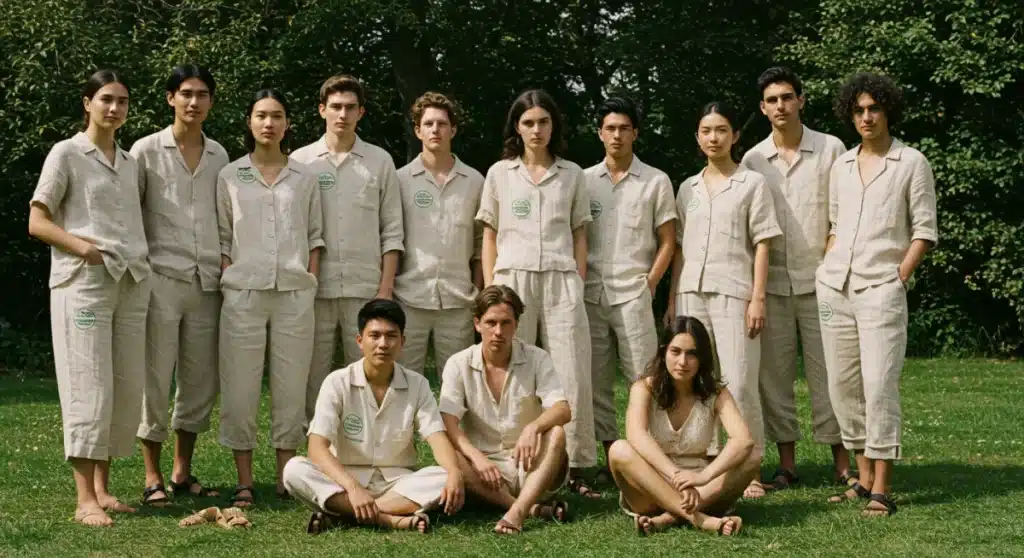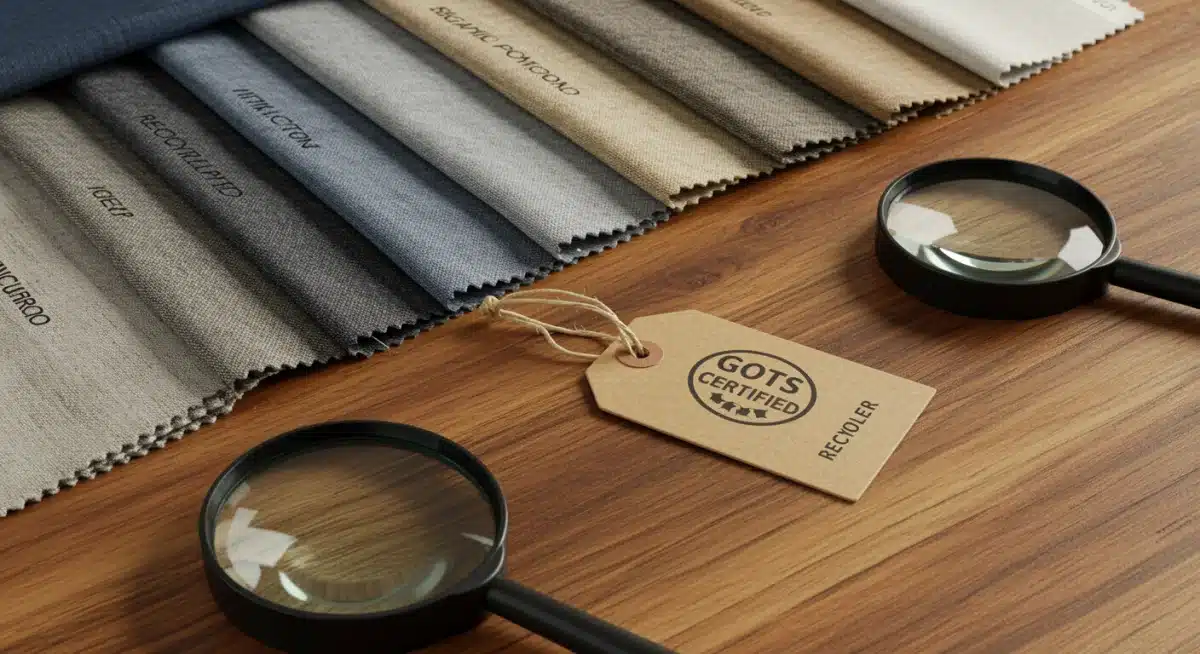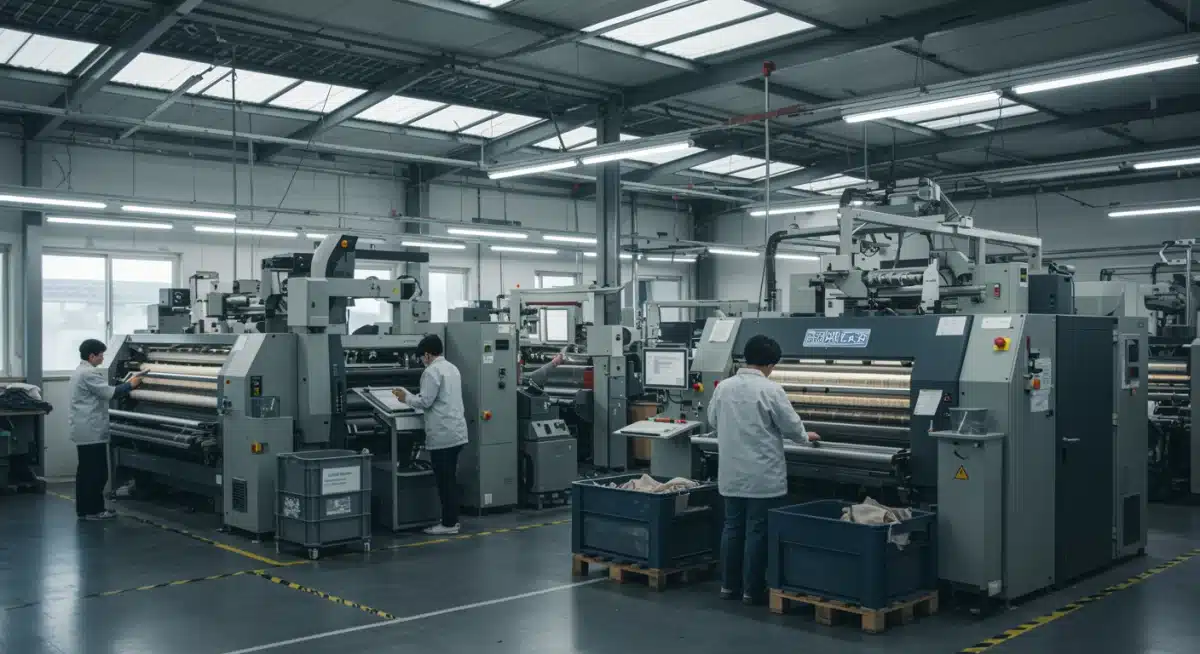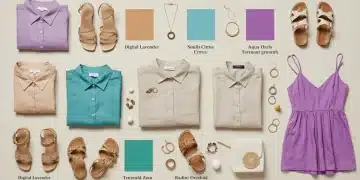Sustainable Summer Fashion 2025: Eco-Friendly Brands Guide

Identifying genuinely eco-friendly brands for sustainable summer fashion in 2025 requires a critical look at material sourcing, ethical labor, and transparent supply chains, moving beyond greenwashing to support true environmental stewardship.
Sustainable summer fashion is now a critical consideration for consumers worldwide, especially in the United States, as the industry evolves and environmental awareness grows. This updated guide for 2025 aims to cut through the noise, offering clear, actionable insights into how to identify brands truly committed to eco-friendly practices amidst a sea of marketing claims.
The Evolving Landscape of Sustainable Summer Fashion in 2025
The conversation around sustainable summer fashion has intensified, moving beyond mere buzzwords to demand concrete evidence of environmental and social responsibility. As summer approaches in 2025, consumers are increasingly seeking out brands that offer transparency and verifiable eco-friendly credentials.
This shift reflects a broader understanding of fashion’s impact, from resource depletion and pollution to ethical labor practices. Identifying truly sustainable brands requires navigating a complex web of certifications, material innovations, and corporate commitments, ensuring that your summer wardrobe aligns with your values.
Beyond Greenwashing: What to Look For
- Transparency Reports: Leading sustainable brands publish annual reports detailing their environmental impact, supply chain, and labor practices. Look for comprehensive data, not just vague statements.
- Certifications: Verify third-party certifications like GOTS (Global Organic Textile Standard), Fair Trade Certified, OEKO-TEX, and B Corp. These indicate adherence to strict environmental and social standards.
- Material Sourcing: Prioritize natural, organic, or recycled materials such as organic cotton, linen, hemp, Tencel (lyocell), recycled polyester, and innovative bio-based fabrics. Avoid virgin synthetic materials when possible.
The market is saturated with brands claiming sustainability, making it challenging for consumers to distinguish genuine efforts from superficial marketing. A critical approach, focusing on verifiable facts and independent assessments, is crucial for making informed choices in sustainable summer fashion.
Understanding Eco-Friendly Materials and Their Impact
The foundation of sustainable summer fashion lies in the materials used. Not all natural fibers are created equal, and some synthetic materials, when recycled, can offer a more eco-conscious alternative to their virgin counterparts. Understanding the lifecycle and environmental footprint of these materials is paramount.
Brands genuinely committed to sustainability will often highlight their material choices, detailing where they come from, how they are processed, and their end-of-life potential. This commitment extends to minimizing water usage, reducing chemical pollutants, and ensuring fair treatment of workers involved in material production.
Key Sustainable Fabrics for Summer
- Organic Cotton: Grown without harmful pesticides or synthetic fertilizers, reducing soil and water pollution.
- Linen: Made from flax, it requires minimal water and pesticides, is durable, and biodegradable.
- Hemp: A highly sustainable crop that needs little water, improves soil health, and is incredibly strong.
- Tencel (Lyocell): A cellulosic fiber from sustainably sourced wood pulp, produced in a closed-loop system that recycles water and solvents.
- Recycled Polyester: Made from plastic bottles or textile waste, reducing reliance on virgin fossil fuels and diverting waste from landfills.
The choice of material significantly impacts a garment’s overall sustainability. For sustainable summer fashion, prioritize breathable, lightweight fabrics that are not only eco-friendly but also comfortable in warm weather. Supporting brands that invest in innovative, low-impact materials helps drive the industry toward a more circular economy.
The Importance of Ethical Labor and Supply Chain Transparency
Beyond materials, truly sustainable summer fashion brands prioritize ethical labor practices and complete supply chain transparency. Exploitative labor conditions are rampant in the fashion industry, and a brand cannot be considered truly eco-friendly without addressing the human element of its production.
Consumers in 2025 are demanding to know not just what their clothes are made of, but who made them and under what conditions. Brands that share detailed information about their factories, worker wages, and safety standards demonstrate a higher level of commitment to true sustainability.
Verifying Ethical Production
- Fair Trade Certification: Ensures fair wages, safe working conditions, and community development for workers.
- Worker Empowerment Programs: Brands that invest in worker training, education, and health initiatives.
- Factory Audits: Regular, independent audits of manufacturing facilities to ensure compliance with labor laws and ethical standards.
A brand’s commitment to ethical labor extends throughout its entire supply chain, from the farms producing raw materials to the factories assembling garments. This holistic approach is a hallmark of genuinely sustainable summer fashion brands, providing consumers with confidence that their purchases do not contribute to human exploitation.
Certifications and Standards: Your Guide to Authenticity
Navigating the world of sustainable fashion can be overwhelming due to the multitude of certifications and standards. However, these third-party verifications are crucial tools for identifying genuinely eco-friendly brands. They provide objective evidence that a brand meets specific environmental and social criteria, reducing the risk of greenwashing.
For sustainable summer fashion, understanding what each certification signifies empowers consumers to make informed decisions. These labels act as a trusted stamp of approval, often backed by rigorous auditing processes and ongoing compliance checks.
Key Certifications Explained
- GOTS (Global Organic Textile Standard): The leading textile processing standard for organic fibers, including ecological and social criteria, backed by independent certification of the entire textile supply chain.
- OEKO-TEX Standard 100: Certifies that textiles and fabrics are free from harmful substances at all stages of production.
- Bluesign: A system that provides solutions for sustainable textile production, eliminating harmful substances from the beginning of the manufacturing process.
- B Corp Certification: Awarded to companies meeting high standards of verified performance, accountability, and transparency on factors from employee benefits and charitable giving to supply chain practices and input materials.
When selecting sustainable summer fashion, always look for these recognized certifications. They offer a reliable shortcut to verifying a brand’s claims, ensuring you support companies that are truly dedicated to environmental protection and social responsibility.

Innovative Approaches to Circularity and Longevity
True sustainable summer fashion goes beyond just initial production; it embraces the entire lifecycle of a garment, emphasizing circularity and longevity. Brands leading this charge are designing clothes that last longer, can be repaired, recycled, or biodegraded, minimizing waste and resource consumption.
In 2025, consumers are increasingly interested in brands that offer repair services, take-back programs, or design for disassembly. These initiatives challenge the traditional linear model of fashion (take-make-dispose) and push towards a more regenerative system.
Designing for Durability and End-of-Life
Brands focused on longevity often use higher-quality materials and construction techniques, ensuring garments withstand multiple wears and washes. This reduces the need for frequent replacements, a key aspect of sustainable consumption. Furthermore, they are exploring innovative ways to manage garments at the end of their useful life.
- Repair Services: Offering in-house or partnered repair options to extend garment lifespan.
- Take-Back Programs: Collecting old garments from customers for recycling, upcycling, or proper disposal.
- Design for Disassembly: Creating garments with components that can be easily separated and recycled individually.
Supporting brands that prioritize circularity means investing in sustainable summer fashion that has a minimal environmental footprint throughout its entire existence, not just at the point of purchase. This forward-thinking approach is vital for a truly sustainable future in fashion.
Consumer Action: Making Informed Choices in 2025
Ultimately, the power to drive change in sustainable summer fashion lies with the consumer. By making informed choices, asking critical questions, and supporting genuinely eco-friendly brands, individuals can collectively push the industry towards more responsible practices. This involves educating oneself and being discerning about marketing messages.
In 2025, the proliferation of information and digital tools makes it easier than ever to research brands and verify their sustainability claims. Every purchase is a vote for the kind of fashion industry we want to support, making conscious consumerism a powerful force for good.
Tips for Conscious Shopping
- Research Brands Thoroughly: Utilize online resources, sustainability directories, and brand websites to investigate their practices.
- Read Reviews and Reports: Look for independent assessments and consumer reviews regarding a brand’s sustainability claims.
- Ask Questions: Don’t hesitate to reach out to brands directly with questions about their supply chain, materials, or labor practices.
- Invest in Quality Over Quantity: Choose durable, timeless pieces that will last, reducing the need for frequent purchases.
By actively engaging with the principles of sustainable summer fashion, consumers become agents of change. Their collective demand for transparency and ethical production can reshape the industry, leading to a future where stylish clothing doesn’t come at the expense of people or the planet.

The Role of Policy and Industry Initiatives in Sustainability
While consumer demand is vital, policy and industry-wide initiatives also play a critical role in shaping the future of sustainable summer fashion. Governments, NGOs, and industry consortiums are increasingly implementing regulations and standards designed to reduce fashion’s environmental impact and improve labor conditions.
These top-down efforts complement grassroots consumer movements, providing a framework for accountability and driving systemic change. In 2025, we are seeing more collaborative efforts aimed at standardizing sustainability metrics and incentivizing eco-friendly practices across the entire supply chain.
Key Policy and Industry Drivers
Regulations such as extended producer responsibility (EPR) schemes are gaining traction, holding brands accountable for the entire lifecycle of their products, including disposal and recycling. Furthermore, initiatives promoting circular economy principles are encouraging innovation in material science and production processes.
- Government Regulations: New laws targeting textile waste, chemical usage, and labor rights.
- Industry Coalitions: Groups working together to set common sustainability goals and benchmarks.
- Technological Advancements: Innovations in textile recycling, bio-fabric development, and transparent supply chain tracking (e.g., blockchain).
These policy and industry changes create a more level playing field for sustainable summer fashion brands, making it harder for less scrupulous companies to greenwash their practices. They also provide clearer guidelines for consumers and businesses alike, fostering a more truly eco-conscious fashion ecosystem.
| Key Aspect | Brief Description |
|---|---|
| Material Sourcing | Focus on organic, recycled, or innovative low-impact fabrics like Tencel and hemp. |
| Ethical Labor | Verify fair wages, safe conditions, and transparent supply chains through certifications. |
| Certifications | Look for GOTS, Fair Trade, OEKO-TEX, and B Corp for third-party verification. |
| Circularity | Support brands designing for longevity, offering repair, or take-back programs. |
Frequently Asked Questions About Sustainable Summer Fashion
In 2025, “eco-friendly” in summer fashion means brands use sustainable materials, ensure ethical labor, minimize waste, and have transparent supply chains. It also implies a commitment to circularity, where products are designed for longevity and eventual recycling or biodegradability, reducing environmental impact throughout their lifecycle.
To avoid greenwashing, look for specific, verifiable claims rather than vague terms like “natural.” Check for third-party certifications (GOTS, Fair Trade, B Corp), detailed impact reports, and transparency about supply chains. Brands with genuine commitments provide tangible evidence of their sustainability efforts, often publicly accessible.
The best materials for sustainable summer fashion include organic cotton, linen, hemp, and Tencel (lyocell) due to their lower environmental footprint. Recycled materials like recycled polyester are also excellent choices as they reduce reliance on virgin resources and divert waste from landfills, promoting a circular economy.
Not necessarily. While higher prices often reflect quality materials and ethical production, affordability doesn’t always indicate a lack of sustainability. Research is key: some affordable brands have strong eco-credentials, while some expensive brands might still lack full transparency. Focus on certifications and brand practices, not just price.
Certifications are crucial as they provide independent verification of a brand’s environmental and social claims. Labels like GOTS, OEKO-TEX, and Fair Trade ensure products meet stringent standards, covering everything from chemical use to labor rights. They offer consumers a reliable way to trust a brand’s commitment to sustainable summer fashion.
What this means
The updated guide for identifying genuinely eco-friendly brands in sustainable summer fashion for 2025 reflects a growing movement where style and responsibility must coexist. As consumers become more informed, the expectation is no longer just about aesthetics but about the full lifecycle of a garment — from sourcing and production to longevity and recyclability. This deeper awareness signals a powerful cultural transition where fashion choices are aligned with environmental values rather than fast-consumption habits.
Transparency, traceable supply chains, and authentic sustainability commitments will increasingly define which brands gain consumer trust. Exploring curated directories of ethical labels like https://luxurylondon.co.uk/style/hers/sustainable-fashion-brands/ can help shoppers navigate this landscape with clarity, identifying brands that genuinely prioritize responsible production over marketing buzzwords. With tools and resources becoming more accessible, consumers hold significant influence in driving change through mindful purchasing decisions.
Ultimately, this shift positions sustainable fashion as more than a seasonal trend — it becomes a long-term framework for how wardrobes are built. By embracing circular design principles and supporting brands that meet verified environmental standards, individuals can actively contribute to a fashion economy that values both beauty and planetary well-being.





